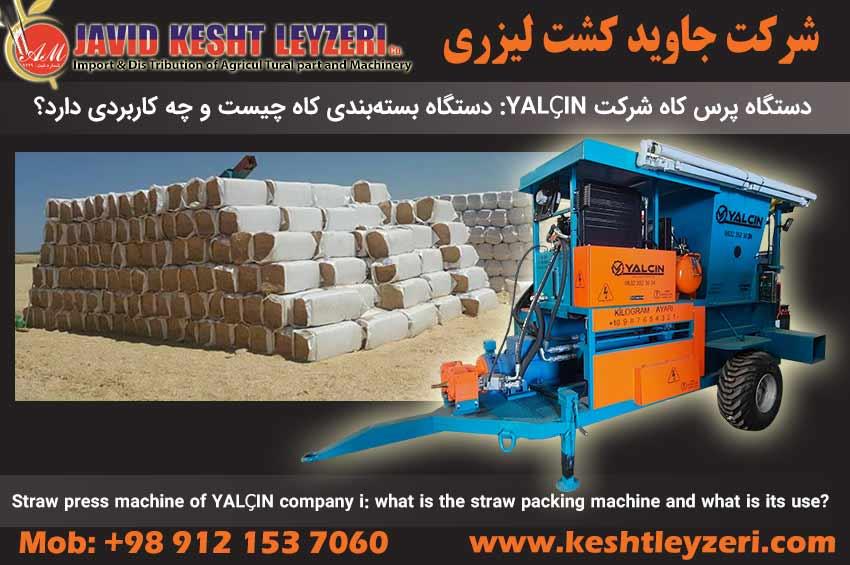
Abnormal factors of the corn plant
javid keshtleyzeri Co.ltd
In many cases, the abnormality of corn cobs is caused by environmental conditions such as temperature, drought, lack of food, pests and diseases, use of inappropriate chemicals or incorrect use of chemicals. Below are some types of abnormal cobs in corn along with some related symptoms and reasons.
1- The narrowness of the end of the cob
Symptoms: the number of rows may be halved from the bottom to the top of the ear (eg - from 16 to 7-8 rows/ear). Cob length is usually normal.
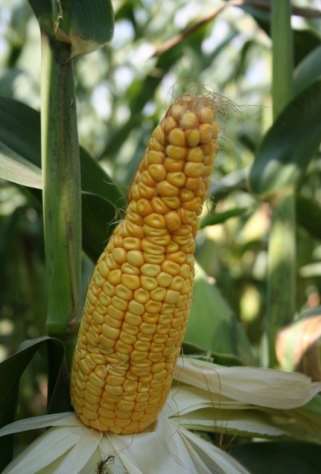
Reasons: Severe stress during the 7-10-leaf stage may result in reduced number of seeds per row. Late application of sulfonylurea herbicides can lead to narrowness of the cob ends.
2- Short ears
Symptoms: The size of the cobs and the number of seeds per row are significantly reduced. Cob coverage, length and number of rows may be normal and sometimes it is associated with multiple cobs in one node. The probability of occurrence in a field is usually rare and scattered. At the end of the seed filling period, the cob cover and leaves turn red and purple.
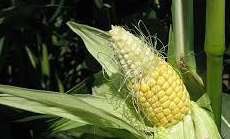
Cause: unknown related to temperature stress (abbreviation of cold shock) in its intensity varies between (V to 12 V early stages of cob formation) hybrids stage 8.
3- Cob clustering
Symptoms: This condition occurs when several cobs are formed from a corn stem node.
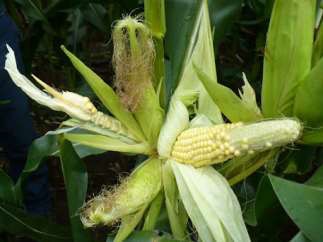
Cause: The main causes of this complication have not yet been fully determined. But heat stress at the beginning of formation and development may cause this complication V to 15 V of cob bud and in stage 5. Also, improper use of herbicides, fungicides, and insecticides before the emergence of silk can be involved in this phenomenon.
4-Cob damaged by drought
Symptoms: small malformed ears with low number of seeds especially at the tip of the ear. The decrease in the number of seeds is related to the decrease in the number of rows and the decrease in the number of seeds per row.
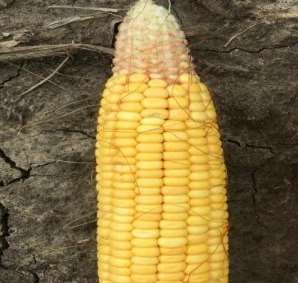
Cause: Severe drought from mid-vegetative growth to early and even mid-grain filling period. Other stresses, including nitrogen deficiency and high plant density, can result in incomplete cobs.
5- Cobs of crown flower (misplaced cobs)
Symptoms: The ear and corolla (tassel) are combined into one structure - a spiked tassel - the tassel ear usually has a limited number of seeds. Spiked tassels usually appear on branched stalks of corn with natural spikes and tassels. These spiked tassels usually appear at the end of the hair, which is the natural location of the tassel.
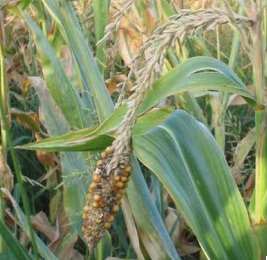
Causes: Misplaced cobs are often produced by weeds when the growing point is damaged and destroyed by hail, frost, herbicides, mechanical damage, or flooding. Some hybrids in certain environmental conditions may be more prone to panicles and these panicles increase the formation of misplaced ears. These aberrant cobs often develop at the edge of the field where early season soil compaction and saturated soil conditions may contribute to the development of this abnormality.
6- Cob diploid rot
Symptoms: Part or all of the cob is covered by a white mold growing between the seeds. Infection generally progresses from the base of the cob to the tip of the cob. Then the white mold changes its color to brown-gray and covers the cobs and seeds as well. The entire cob may be shrunk and the infected seeds appear to be glued to the cob cover. Different hybrids differ in this sensitivity.
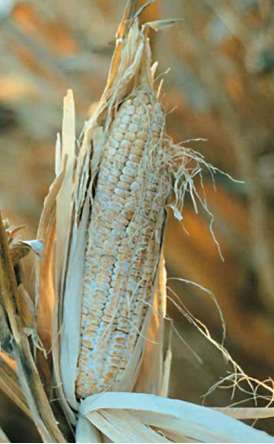
Cause: Diplodia ear rot is caused by the fungus Stenocarpella maydis. Infection may occur from the late vegetative stages until 3 weeks after the silking stage.
7- Weak pollination at the tip of the cob
Symptoms: Visibility of the wood texture of the cob without seeds in the last few centimeters of the cob. The ovules are not fertilized at the tip of the cob.
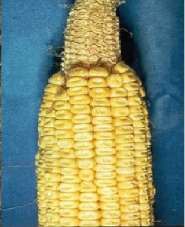
Reasons: poor fertilization of cob tip eggs during silking. Like what happens in low-seeded and incomplete cobs.
8-Cobs with few seeds and incomplete
Symptoms: The number of seeds is reduced and the ear is incomplete. Only a limited number of seeds (eggs) are pollinated. In extreme conditions, only cob wood texture is seen with a few scattered grains and the grain rows are not clear.
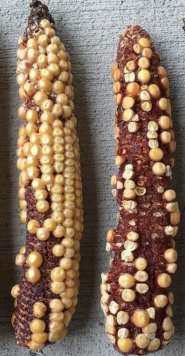
Many reasons: poor pollination of cobs due to the asynchrony of pollen fall and emergence of silk due to extreme dryness and high temperature, insufficient pollen due to uncoordinated growth and development of stems, herbicides, insect feeding and interruption of silk production, lack of phosphorus in pollination. Weakly effective.
9- The tip of the cob is turned back
Symptoms: Weakness of seed filling at the tip of the cob. Not filling the last few centimeters of the cob. Aborted seeds at the end of the cob in the stages of seed swelling and milking, usually with the lack of fertilization of eggs at the end of the cob, unfertilized eggs and aborted seeds at the end of the cob look small and dry, but Aborted seeds often have a yellowish color.
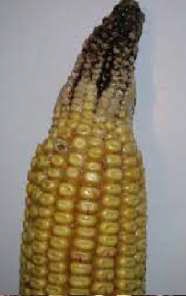
Reasons: Stress conditions in the early period of seed growth and development, including severe drought and high temperature, nitrogen deficiency, foliar diseases and cloudy weather.
10- Zip shaped cobs
Symptoms: complete or partial loss of seed rows in the cob primarily due to abortion.

Causes: often unknown, associated with severe drought stress or damage from defoliation after pollination
11- Banana-shaped cobs
Symptoms: when part of the rows of seeds in the cob are completely or incompletely aborted and bending the cob to one side causes the cob to become a banana fruit.
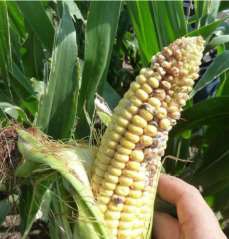
Causes: often unknown, associated with severe drought stress or damage from defoliation after pollination
12- Bilal Pok
Symptoms: Light, low-seeded cobs with shrunken seeds. The gaps between the seeds indicate that the ear is not full.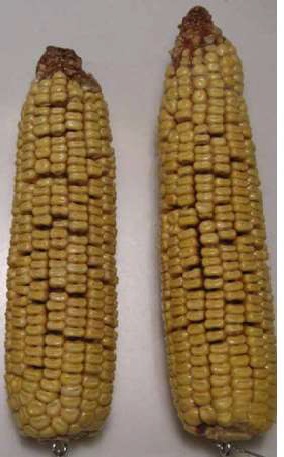
Multiple causes: severe stress (photosynthetic stress) in the pulp stage, including damage caused by R5 and the early stages of seed depression R4, cold, premature death of the plant due to drought, high plant density, leaf diseases, severe potassium deficiency and hail.
13- Wormed cobs:
Scattered destruction of seeds in part or the whole cob. Damage is often associated with mold growth on injured seeds
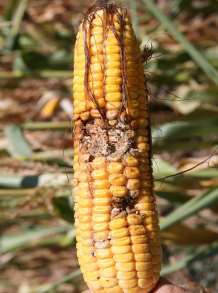
Causes: The feeding of corn by the larvae of corn pests, which tend to destroy limited parts of the cob and often enter from the side of the cob cover. Seeds, especially damaged seeds, may be attacked by molds or secondary pests that enter through pathways created by pest larvae.
14- Damage to birds
Symptoms: cob lightness, opening of damaged area from birds and exposure to air, discolored moldy seeds exposed to bird feeding and insects.
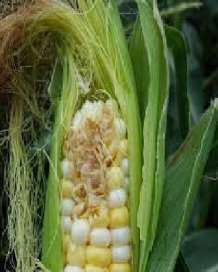
Causes: Poor cob cover at maturity, combined with upright cobs, allows birds to feed on cob tips, which may also lead to secondary insect feeding. Accumulation of moisture at the base of the cob promotes mold and may lead to scattered seed germination.
15-Redness of seed veins
Symptoms: Red streaks develop and spread from around the seed to the seed cap. It is usually confined to the cob tip seeds.
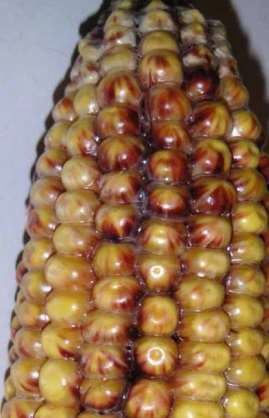
Causes: caused by the poison produced by feeding by the wheat ring mite. The severity of symptoms in different hybrids is different.





